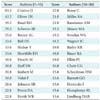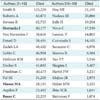I. Introduction
II. Methods
Time line analysis of the occurrence of the phrase "medical concept representation" using the Scopus term analyser [4], extraction of the contextual environment using Ultimate Research Assistant [5] and visualization of the results using a tag cloud [6];
Using the tool Publish or Perish [7] to identify the authors of the most influential papers, using seven sources, viz. Web of Science, Scopus, Embase, PubMed, Google Scholar, Cochrane Library, British Library on-line catalogue. The question was to have an idea of the persistence of the influential authors from the first period to the second one. The Boolean search expression "concept representation" AND ("medical" OR "medicine") AND ("knowledge" OR "information") was submitted to all of them, with variations according to their proprietary syntax. For identifying the top ten papers, the results of the seven lists were consolidated into a common table. For this, available citation ranks were taken, otherwise the source's own ranking mechanism was used. In the following, the top ten papers were the source for extracting the top thirty authors, which were ranked in a second step. For this, the following heuristics was used: The nth author in the list was assigned a score of 11 - n, the eleventh and following authors was given a zero value. The scoring was weighted, favouring multiple appearances of authors in different sources: a final score was calculated as a net score (0.8 + 0.2 × occurrence).
In the post-2000 analysis, due to the significant drop of the usage of the exact phrase "medical concept representation" the resulting paper population would have been too small for applying the same procedure as described for the first period. Therefore, instead of summing up the citation data only for papers matching the query, here the citation data for all papers per author were used. This same method, however, could not be used for same analysis backwards to the previous period, due to limitations of the tool used [7].
The hypothesis of a paradigm shift was studied, comparing relevant papers published during the years from 1988 to 1999 with those appearing between 2000 and 2012, focusing the same subject area. The reason for starting with 1988 was the availability of bibliographic databases, being almost accordant with the period of our interest, viz. the activities of the IMIA WG on Medical Knowledge Representation. Author lists were compared and all the titles of the two full paper sets were text mined using Textalyser [8].
The second, more recent set was cross-checked against a third set from the same period, obtained by an online survey targeted to the specifically interested audience. For this survey (open from August to October 2012) the primary source was the LinkedIn group of the MCR WG, having at that time over fifty members of widely various backgrounds. Secondary sources were additional LinkedIn Groups in broader domain. Participants were asked to quote and to share the papers they found to be most influential in their work or research. We used Datagle [9] and a Google document to collect survey data.
III. Results
1. Looking Back: 'Medical Concept Representation' before the Turn of the Millennium
2. "Medical Concept Representation" Since the Year 2000
3. Mapping the Conceptual Context of Most Influential Papers Based on Text Mining of Titles
4. Results of the Survey Taken Show the Opinion of Socially Active Researchers Interested in the Domain
IV. Discussion
1. Methodology Issues Regarding the Literature Study
2. Current Trends
Propagation of the paradigm of ontological realism, the proponents of which have been arguing against the usage of this word in the context of ontologies, contending that the representation of concepts as "entities of thought" is inappropriate for the representation of a scientific domain and obfuscates the difference between the entities and names given to them [32];
The preference of "class" over "concept" in the Semantic Web and description logics community, especially regarding the influential OWL family of representation languages [33];
The obvious polysemy of the word itself [34].
V. Conclusion
The capture of medical information and knowledge leverages (standards) ontologies;
Open reference resources for content are developed collaboratively, shared, and reused;
Web enabled standards help achieve transparent results;
"Big data" opens new ways for knowledge acquisition;
However, a large part of clinical information continues being recorded as free text, which keeps the need of processing medical language on the research agenda.




 PDF
PDF ePub
ePub Citation
Citation Print
Print










 XML Download
XML Download